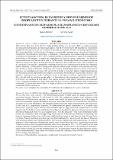Por favor, use este identificador para citar o enlazar este ítem:
https://hdl.handle.net/20.500.12958/6583Registro completo de metadatos
| Campo DC | Valor | Lengua/Idioma |
|---|---|---|
| dc.contributor.author | Aronés Flores, Katia | - |
| dc.contributor.author | Ayón Dejo, Patricia | - |
| dc.date.accessioned | 2022-12-22T20:24:29Z | - |
| dc.date.available | 2022-12-22T20:24:29Z | - |
| dc.date.issued | 2022-12 | - |
| dc.identifier.citation | Arones, K., Ayón, P. (2022). Ictioplancton, eufáusidos y biovolúmenes de zooplancton durante el verano-otoño 2015. Bol Inst Mar Perú. 37(2): 234-255. | es_ES |
| dc.identifier.issn | 04587766 | - |
| dc.identifier.uri | https://hdl.handle.net/20.500.12958/6583 | - |
| dc.description.abstract | Se recolectaron 144 muestras de zooplancton empleando red Hensen de 300 μm de abertura de malla, en arrastres verticales con el buque parado hasta 50 m de profundidad. Se determinaron 18 especies de eufáusidos pertenecientes a los géneros Euphausia, Nematoscelis, Nematobrachion, Nyctiphanes y Stylocheiron. Predominaron los estadios tempranos calyptopis y furcilias con frecuencias de 68% y 87%, respectivamente. Se determinaron 63 especies de ictioplancton distribuidas en 35 familias. La especie más abundante fue Engraulis ringens “anchoveta”, sus huevos y larvas oscilaron de 3 a 4.566 huevos/m2 y de 3 a 2.574 larvas/m2, distribuidos desde Talara hasta San Juan de Marcona. Los huevos y larvas de Vinciguerria lucetia fluctuaron de 3 a 4.212 huevos/m2 y de 3 a 1.512 larvas/ m2, reportados por fuera de la plataforma continental; los huevos se distribuyeron de Punta Sal a Pimentel, frente a Salaverry y de Huarmey a San Juan de Marcona, mientras que las larvas se encontraron de Punta Sal a Punta La Negra, de Pimentel a Salaverry, de Huarmey a bahía Independencia y frente a San Juan de Marcona, con densidades mayores a 500 larvas/100 m2 frente a Punta Sal, Talara y bahía Independencia. Por frecuencia, fueron importantes otras especies de la familia Myctophidae: Diogenichthys laternatus “pez linterna”, Lampanyctus parvicauda, Triphoturus oculeus y Myctophum nitidulum, registradas en 35%, 11%, 8% y 6% del total de muestras recolectadas. Los biovolúmenes de zooplancton oscilaron entre 0,001 y 5,72 mL/m3, con mediana de 0,62 mL/m3. Los valores menores a 0,26 mL/m3 fueron los más frecuentes (47%) y estuvieron distribuidos desde Paita hasta San Juan Marcona, principalmente sobre la plataforma continental. En particular, entre Punta La Negra y Salaverry se localizaron por fuera de la plataforma continental a 80 mn de la costa. | es_ES |
| dc.description.abstract | ABSTRACT: The 1502-04 hydroacoustic research cruise for pelagic resources was conducted between February 22 and March 31, 2015. 144 zooplankton samples were collected, using Hensen net of 300 μm mesh opening, in vertical trawls with the vessel stationary up to 50 m deep. A total of 18 euphausiid species belonging to the genera Euphausia, Nematoscelis, Nematobrachion, Nyctiphanes, and Stylocheiron were determined. The calyptopis and furcilia early stages predominated with frequencies of 68% and 87%, respectively. Likewise, 63 ichthyoplankton species distributed in 35 families were determined. Engraulis ringens was the most abundant species. Eggs and larvae ranged from 3 to 4,566 eggs/m2 and 3 to 2,574 larvae/m2 distributed from Talara to San Juan de Marcona. Vinciguerria lucetia eggs and larvae fluctuated from 3 to 4,212 eggs/m2 and 3 to 1,512 larvae/m2. They were distributed mainly outside the continental shelf, with eggs being found between Punta Sal and Pimentel, off Salaverry, and between Huarmey and San Juan de Marcona, while the larvae were located between Punta Sal and Punta La Negra, Pimentel and Salaverry, Huarmey and Independencia Bay, as well as off San Juan of Marcona, with densities greater than 500 larvae/100 m2 off Punta Sal, Talara, and Independencia Bay. In terms of frequency, other important Myctophidae species were Diogenichthys laternatus, Lampanyctus parvicauda, Triphoturus oculeus, and Myctophum nitidulum, which were recorded in 35%, 11%, 8%, and 6% of the total samples collected. Zooplankton biovolumes ranged from 0.001 to 5.72 mL/m3, with a median of 0.62 mL/m3. Values below 0.26 mL/m3 were the most frequent (47%) occurring from Paita to San Juan Marcona, mainly on the continental shelf. These values were located outside the continental shelf at 80 nm offshore between Punta La Negra and Salaverry. | - |
| dc.language.iso | spa | es_ES |
| dc.publisher | Instituto del Mar del Perú | es_ES |
| dc.relation.ispartofseries | Boletín IMARPE 37(2), 2022; | - |
| dc.rights | info:eu-repo/semantics/openAccess | es_ES |
| dc.rights.uri | https://creativecommons.org/licenses/by/4.0/ | es_ES |
| dc.source | Instituto del Mar del Perú - IMARPE | es_ES |
| dc.source.uri | Repositorio Digital IMARPE | es_ES |
| dc.subject | Ictioplancton | es_ES |
| dc.subject | Eufáusidos | es_ES |
| dc.subject | Biovolúmenes de zooplancton | es_ES |
| dc.subject | Engraulis ringens | es_ES |
| dc.title | Ictioplancton, eufáusidos y biovolúmenes de zooplancton durante el verano-otoño 2015 | es_ES |
| dc.title.alternative | Ichthyoplankton, euphausiids, and zooplankton biovolumes (summer-autumn 2015) | es_ES |
| dc.type | info:eu-repo/semantics/article | es_ES |
| dc.publisher.country | Perú - Callao | es_ES |
| dc.subject.ocde | http://purl.org/pe-repo/ocde/ford#1.05.11 | es_ES |
| Aparece en las colecciones: | Boletín 37(2) 2022 | |
Ficheros en este ítem:
| Fichero | Descripción | Tamaño | Formato | |
|---|---|---|---|---|
| Boletin 37-2 artículo2.pdf | 1,38 MB | Adobe PDF |  Visualizar/Abrir |
Este ítem está sujeto a una licencia Creative Commons Licencia Creative Commons

